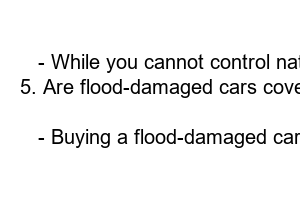침수차 확인하는 방법
How to Check for Flood Damage in a Car
Have you ever come across a used car that seems like a great deal, only to find out later that it has been submerged in water during a flood? A flood-damaged car can be a nightmare for any buyer, as it can lead to various mechanical and electrical issues that may go unnoticed initially. In this blog post, we will guide you through the process of checking a car for flood damage, so you can make an informed decision before purchasing a used vehicle.
1. Check for Water Stains and Mold
– Inspect the upholstery, carpeting, and headliner for water stains or signs of mold. Even if the car has been cleaned, the presence of water stains or a musty smell can indicate a previous flood.
2. Examine the Interior
– Look for rust or corrosion on metal components such as seat frames, pedals, and door hinges. Additionally, check for any malfunctioning electrical components, as water damage can cause a short circuit.
3. Inspect the Engine
– Open the hood and carefully inspect the engine bay for mud, silt, or signs of water residue. *Check the oil dipstick for a milky or foamy appearance, which could indicate water contamination in the engine.*
4. Analyze the Electrical Systems
– Test all electrical functions such as lights, windows, air conditioning, and radio. *If any of these systems are not working properly, it may be a result of water damage.*
5. Conduct a Smell Test
– Take a good sniff inside the car. If you detect a strong odor of mold or mildew, it’s a telling sign of flood damage.
6. Get a Professional Inspection
– It is always wise to have a trusted mechanic perform a comprehensive inspection of the vehicle before making a purchase. They can identify any hidden issues caused by flood damage.
7. Check the Vehicle History Report
– Obtain a vehicle history report using the car’s vehicle identification number (VIN). This report will provide valuable information regarding accidents, floods, or any other incidents the car might have been involved in.
In summary, flood-damaged cars can be a nightmare, but by following these steps, you can protect yourself from making a costly mistake. Inspect the car thoroughly for water stains, mold, rust, electrical issues, and unusual smells. If needed, seek professional assistance and always obtain a vehicle history report. By doing so, you’ll ensure a safer and more reliable purchase.
Frequently Asked Questions (FAQs):
1. Can a car that has been in a flood still be sold?
– Yes, but it is unethical to sell a flood-damaged car without disclosing the information to the buyer.
2. Can a carfax report reveal flood damage?
– Yes, a Carfax report can provide valuable information regarding flood damage or any other incidents the car may have been involved in.
3. How much does it cost to repair a flood-damaged car?
– The cost of repairing a flood-damaged car can vary greatly depending on the extent of the damage. It is best to consult a professional mechanic for an accurate estimate.
4. Can I prevent flood damage to my car?
– While you cannot control natural disasters, parking your car in elevated areas or using flood barriers can help reduce the risk of flood damage.
5. Are flood-damaged cars covered by insurance?
– If you have comprehensive auto insurance, it may cover the damages caused by a flood. However, it is best to contact your insurance provider to confirm the coverage.
6. Is it advisable to purchase a flood-damaged car at a significantly reduced price?
– Buying a flood-damaged car can be risky, even at a reduced price. It is recommended to thoroughly inspect the vehicle and consult a mechanic before making a decision.

